DTC P2195 Oxygen (A/F) Sensor Signal Stuck Lean (Bank 1 Sensor 1) |
DTC P2196 Oxygen (A/F) Sensor Signal Stuck Rich (Bank 1 Sensor 1) |
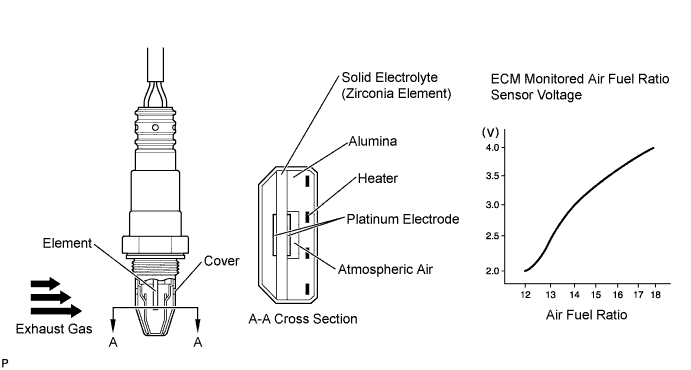
| DTC No. | DTC Detection Condition | Trouble Area |
| P2195 | Conditions (a) and (b) continue for 5 seconds or more (2 trip detection logic)
|
|
| While fuel-cut operation performed (during vehicle deceleration), air fuel ratio sensor current is 2.2 mA or more for 3 seconds (2 trip detection logic) |
| |
| P2196 | Conditions (a) and (b) continue for 5 seconds or more (2 trip detection logic)
|
|
| While fuel-cut operation performed (during vehicle deceleration), air fuel ratio sensor current is less than 0.7 mA for 3 seconds (2 trip detection logic) |
|
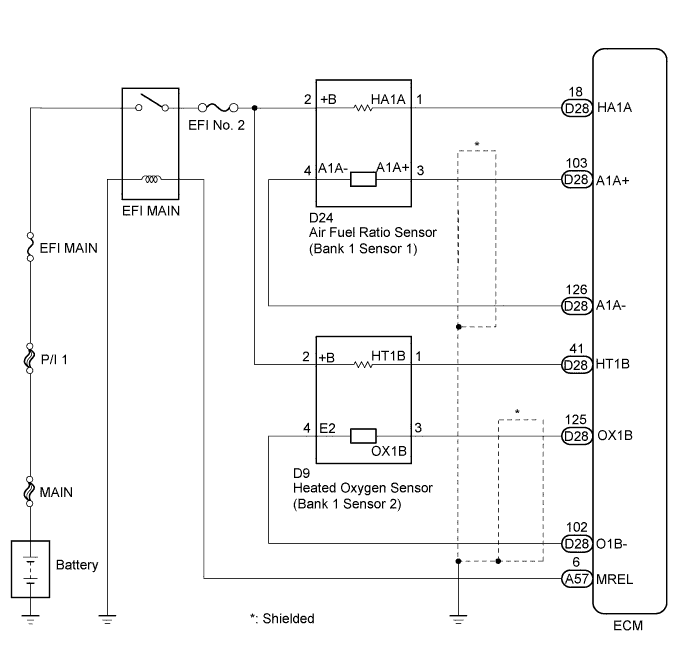
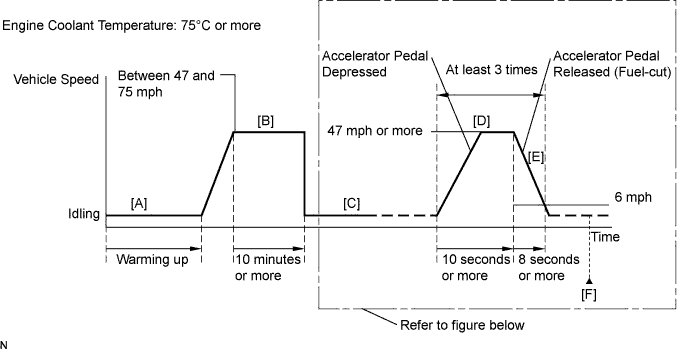
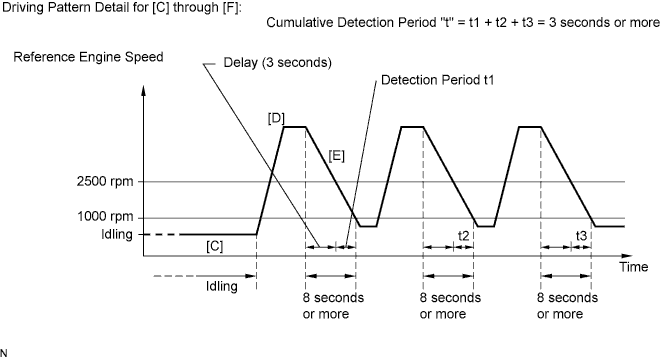
| Tester Display | Description |
| NORMAL |
|
| ABNORMAL |
|
| INCOMPLETE |
|
| UNKNOWN |
|
| Tester Display (Sensor) | Injection Volume | Status | Voltage |
| AFS Voltage B1S1 (Air fuel ratio) | +25% | Rich | Less than 3.1 V |
| AFS Voltage B1S1 (Air fuel ratio) | -12.5% | Lean | More than 3.4 V |
| O2S B1S2 (Heated oxygen) | +25% | Rich | More than 0.55 V |
| O2S B1S2 (Heated oxygen) | -12.5% | Lean | Less than 0.4 V |
| Case | Air Fuel Ratio Sensor (Sensor 1) Output Voltage | Heated Oxygen Sensor (Sensor 2) Output Voltage | Main Suspected Trouble Area |
| 1 | 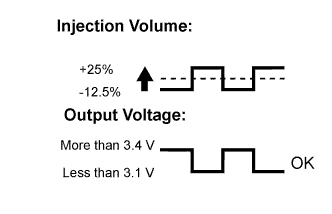 | 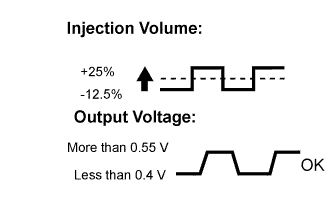 | - |
| 2 | 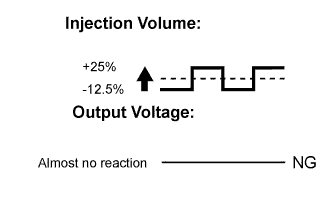 |  |
|
| 3 |  | 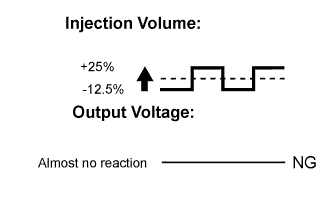 |
|
| 4 |  |  |
|
| 1.CHECK ANY OTHER DTCS OUTPUT (IN ADDITION TO P2195 OR P2196) |
Connect the intelligent tester to the DLC3.
Turn the power switch on (IG).
Turn the tester on.
Enter the following menus: Powertrain / Engine and ECT / DTC.
Read the DTCs.
| Result | Proceed to |
| DTC P2195 or P2196 is output | A |
| DTC "P2195 or P2196" and "P0136, P0137 or P0138" are output | A |
| DTC P2195 or P2196 and other DTCs are output | B |
|
| ||||
| A | |
| 2.CONFIRM IF VEHICLE HAS RUN OUT OF FUEL IN PAST |
Has the vehicle run out of fuel in the past?
|
| ||||
| YES | |
| 3.PERFORM CONFIRMATION DRIVING PATTERN |
Connect the intelligent tester to the DLC3.
Turn the power switch on (IG).
Turn the tester on.
Clear the DTCs (Click here).
Turn the power switch off and wait for 30 seconds.
Turn the power switch on (IG) and turn the tester on.
Put the engine in inspection mode (Click here).
Start the engine and warm it up.
Drive the vehicle in accordance with the driving pattern described Confirmation Driving Pattern.
Enter the following menus: Powertrain / Engine and ECT / Utility / All Readiness.
Input the DTC: P2195 or P2196.
Check the DTC judgment result.
| Result | Proceed to |
| NORMAL (DTC is not output) | A |
| ABNORMAL (DTC P2195 or P2196 is output) | B |
|
| ||||
| A | ||
| ||
| 4.READ VALUE USING INTELLIGENT TESTER (TEST VALUE OF AIR FUEL RATIO SENSOR) |
Connect the intelligent tester to the DLC3.
Turn the power switch on (IG).
Turn the tester on.
Clear the DTCs (Click here).
Put the engine in inspection mode (Click here).
Drive the vehicle in accordance with the drive pattern described in Confirmation Driving Pattern.
Enter the following menus: Powertrain / Engine and ECT / Data List / All Data / AFS Current B1S1.
Check the test value of the air fuel ratio sensor output current during fuel-cut.
| Result | Proceed to |
| Within normal range (0.7 mA or more, and less than 2.2 mA) | A |
| Outside normal range (less than 0.7 mA, or 2.2 mA or more) | B |
|
| ||||
| A | |
| 5.READ VALUE USING INTELLIGENT TESTER (OUTPUT VOLTAGE OF AIR FUEL RATIO SENSOR) |
Connect the intelligent tester to the DLC3.
Turn the power switch on (IG).
Turn the tester on.
Put the engine in inspection mode (Click here).
Start the engine.
Warm up the air fuel ratio sensor at an engine speed of 2500 rpm for 90 seconds.
Enter the following menus: Powertrain / Engine and ECT / Active Test / Control the Injection Volume.
Perform the Control the Injection Volume operation with the engine idling.
Monitor the output voltages of the air fuel ratio and heated oxygen sensors (AFS Voltage B1S1 and O2S B1S) displayed on the tester.
| Tester Display (Sensor) | Injection Volume | Status | Voltage |
| AFS Voltage B1S1 (Air fuel ratio) | +12.0% | Rich | Below 3.1 V |
| AFS Voltage B1S1 (Air fuel ratio) | -12.0% | Lean | Higher than 3.4 V |
| O2S B1S2 (Heated oxygen) | +12.0% | Rich | Higher than 0.55 V |
| O2S B1S2 (Heated oxygen) | -12.0% | Lean | Below 0.4 V |
| Status of AFS Voltage B1S1 | Status of O2S B1S2 | Air Fuel Ratio Condition and Air Fuel Ratio Sensor Condition | Misfire | Suspected Trouble Area | Proceed to |
| Lean | Lean | Actual air fuel ratio lean | May occur |
| A |
| Rich | Rich | Actual air fuel ratio rich | - |
| A |
| Lean | Lean/Rich | Air fuel ratio sensor malfunction | - | Air fuel ratio sensor | B |
| Rich | Lean/Rich | Air fuel ratio sensor malfunction | - | Air fuel ratio sensor | B |
| Lean/Rich | Lean/Rich | Normal | - | - | C |
|
| ||||
|
| ||||
| A | |
| 6.CHECK INTAKE SYSTEM |
Check the intake system for vacuum leaks (Click here).
|
| ||||
| OK | |
| 7.CHECK FOR EXHAUST GAS LEAK |
Check for exhaust gas leaks.
|
| ||||
| OK | |
| 8.CHECK FUEL PRESSURE |
Check the fuel pressure (Click here).
|
| ||||
| OK | |
| 9.INSPECT FUEL INJECTOR ASSEMBLY |
Check the fuel injector assembly injection (whether fuel volume is high or low, and whether injection pattern is poor) (Click here).
|
| ||||
| OK | |
| 10.REPLACE AIR FUEL RATIO SENSOR NO.2 |
Replace the air fuel ratio sensor (Click here).
| NEXT | |
| 11.PERFORM CONFIRMATION DRIVING PATTERN |
Connect the intelligent tester to the DLC3.
Turn the power switch on (IG).
Turn the tester on.
Clear the DTCs (Click here).
Turn the power switch off and wait for 30 seconds.
Turn the power switch on (IG), and turn the tester on.
Put the engine in inspection mode (Click here).
Start the engine and warm it up.
Drive the vehicle in accordance with the driving pattern described in the Confirmation Driving Pattern.
Enter the following menus: Powertrain / Engine and ECT / Utility / All Readiness.
Input the DTC: P2195 or P2196.
Check the DTC judgment result.
| Result | Proceed to |
| ABNORMAL (DTC P2195 or P2196 is output) | A |
| NORMAL (DTC is not output) | B |
|
| ||||
| A | |
| 12.PERFORM ACTIVE TEST USING INTELLIGENT TESTER (CONTROL THE EGR STEP POSITION) |
Connect the intelligent tester to the DLC3.
Turn the power switch on (IG).
Turn the tester on.
Put the engine in inspection mode (Click here).
Start the engine and warm it up until the engine coolant temperature reaches 75°C (167°F) or more.
Enter the following menus: Powertrain / Engine and ECT / Active Test / Control the EGR Step Position.
Confirm the Throttle Idle Position is ON and check the engine idling condition and MAP values in the Data List while performing the Active Test.
| - | EGR Step Position (Active Test) | |
| 0 Steps | 0 to 30 Steps | |
| Idling condition | Steady idling | Idling changes from steady to rough idling |
| MAP (Data List) | MAP value is 20 to 40 kPa (150 to 300 mmHg) (EGR valve is fully closed) | MAP value is at least +10 kPa (75 mmHg) higher than when EGR valve is fully closed |
|
| ||||
|
| ||||
| 13.INSPECT EGR VALVE ASSEMBLY |
Remove the EGR valve assembly (Click here).
Check if the EGR valve is stuck open.
Reinstall the EGR valve assembly (Click here).
|
| ||||
| OK | |
| 14.REPLACE ECM |
Replace the ECM (Click here).
| NEXT | |
| 15.CONFIRM WHETHER MALFUNCTION HAS BEEN SUCCESSFULLY REPAIRED |
Connect the intelligent tester to the DLC3.
Turn the power switch on (IG).
Turn the tester on.
Clear the DTCs (Click here).
Turn the power switch off and wait for 30 seconds.
Turn the power switch on (IG) and turn the tester on.
Put the engine in inspection mode (Click here).
Start the engine and warm it up.
Drive the vehicle in accordance with the driving pattern described in the Confirmation Driving Pattern.
Enter the following menus: Powertrain / Engine and ECT / Utility / All Readiness.
Input the DTC: P2195 or P2196.
Check the DTC judgment result.
| Tester Display | Description |
| NORMAL |
|
| ABNORMAL |
|
| INCOMPLETE |
|
| UNKNOWN |
|
| NEXT | ||
| ||
| 16.REPLACE AIR FUEL RATIO SENSOR NO.2 |
Replace the air fuel ratio sensor (Click here).
| NEXT | |
| 17.PERFORM CONFIRMATION DRIVING PATTERN |
Connect the intelligent tester to the DLC3.
Turn the power switch on (IG).
Turn the tester on.
Clear the DTCs (Click here).
Turn the power switch off and wait for 30 seconds.
Turn the power switch on (IG) and turn the tester on.
Put the engine in inspection mode (Click here).
Start the engine and warm it up.
Drive the vehicle accordance with the driving pattern described in the Confirmation Driving Pattern.
Enter the following menus: Powertrain / Engine and ECT / Utility / All Readiness.
Input the DTC: P2195 or P2196.
Check the DTC judgment result.
| Result | Proceed to |
| NORMAL (DTC is not output) | A |
| ABNORMAL (DTC P2195 or P2196 is output) | B |
|
| ||||
| A | ||
| ||
| 18.CHECK FUEL LINE |
Check the fuel lines for leaks or blockage.
|
| ||||
| OK | ||
| ||